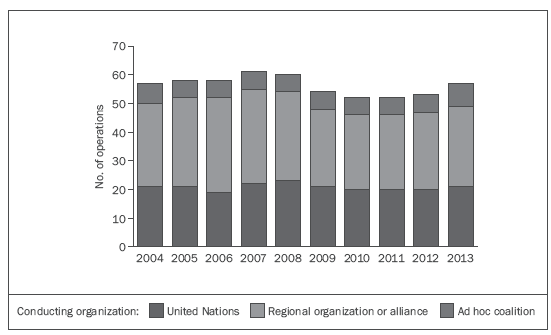Notice: This is only a preliminary collection of relevant material
The data and research currently presented here is a preliminary collection or relevant material. We will further develop our work on this topic in the future (to cover it in the same detail as for example our entry on World Population Growth).
If you have expertise in this area and would like to contribute, apply here to join us as a researcher.
The United Nations was founded after the Second World War with the guiding principle to promote international cooperation and prevent future conflicts. Today, the UN continues to promote peace and has active peacekeeping operations around the world.
In addition to peacekeeping, “peacekeepers are increasingly charged with assisting in political processes; reforming judicial systems; training law enforcement and police forces; disarming and reintegrating former combatants; supporting the return of internally displaced persons and refugees.”1
Interactive charts on Peacekeeping
United Nations Peacekeeping Operations
Since the UN does not have its own military it relies on contributions from member states. The role of these peacekeeping forces is not to engage in combat but to prevent future conflict and support stabilization and rebuilding efforts.
The mandate of the early peacekeeping operations “was primarily limited to maintaining ceasefires and stabilizing situations on the ground, providing crucial support for political efforts to resolve conflict by peaceful means.”2
Modern peacekeeping forces include economists, police officers, legal experts, electoral observers, human rights monitors as well as military personnel.
The chart shoes the number of peacekeeping missions carried out by the United Nations by year.
Other international peacekeeping Operations
Not all peace keeping missions are conducted by the UN. The bar chart shows the breakdown of peacekeeping operations by organisation for the decade 2004-2013.
In many cases, it is regional alliances or organisations that step in to stabilise conflict zones.
Number of peace operations by conducting organizations, 2004-2013 – SIPRI3

The interactive charts show the number of United Nations peacekeepers active over time. This is shown as the total, with additional breakdown by the type of personnel.
Throughout the Cold War, the change in the number of UN peacekeepers roughly corresponds to changes in the number of active operations globally. With the collapse of the Soviet Union and the end of the Cold War, this relationship breaks down. We see large dip in UN personnel size in the late 90s but only smaller reductions in the number of ongoing operations.
A large part of this decline in personnel numbers can be attributed to the failure of the United Nations Operation in Somalia II (UNOSOM II) and the UN’s withdrawal from Somalia in 1995.4
All data on UN peacekeeping operations comes from the UN itself and is available online at https://peacekeeping.un.org/en/.
- Data: SIPRI Multilateral Peace Operations Database; “The SIPRI database on multilateral peace operations provides comprehensive, reliable and authoritative data on all multilateral peace operations (both UN and non-UN) conducted around the world”
- Geographical coverage: Global by country or peacekeeping operation
- Time span: 1948-2014
- Available at: http://www.sipri.org/databases/pko
- Data: Monthly reports on peacekeeping operations
- Geographical coverage: Global by country or peacekeeping operation
- Time span: 1948-2014
- Available at: https://peacekeeping.un.org/en/
- Data: Time series data on peacekeeping
- Geographical coverage: Global
- Time span: 1947-2012
- Available at: https://www.globalpolicy.org
- Data: IPI Peacekeeping Database: “Drawing from archival UN records, the International Peace Institute Peacekeeping Database presents the first publicly available database of total uniformed personnel contributions of each contributing country by month, by type (troop, police, or expert/observer) and by mission, from November 1990 to present.”
- Geographical coverage: Global by country or peacekeeping operation
- Time span: 1947-2012
- Available at: http://www.providingforpeacekeeping.org